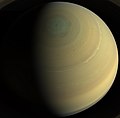File:Saturn's northern hemisphere (close-up).jpg

Original file (1,391 × 1,373 pixels, file size: 501 KB, MIME type: image/jpeg)
| This is a file from the Wikimedia Commons. The description on its description page there is shown below.
Commons is a freely licensed media file repository. You can help. |
Summary
| DescriptionSaturn's northern hemisphere (close-up).jpg |
English: A swing high above Saturn by NASA's Cassini spacecraft revealed this stately view of the planet and its main rings. The view is in natural colour, as human eyes would have seen it. This mosaic was made from 36 images in three colour filters obtained by Cassini's imaging science subsystem on 10 October 2013. The observation and resulting image mosaic were planned as one of three images for Cassini's 2013 Scientist for a Day essay contest.
Saturn sports differently-coloured bands of weather in this image. For instance, a bright, narrow wave of clouds around 42 degrees north latitude appears to be some of the turbulent aftermath of a giant storm that reached its violent peak in early 2011. The mysterious six-sided weather pattern known as the hexagon is visible around Saturn's north pole. When Cassini arrived in 2004, more of the northern hemisphere sported a bluish hue and it was northern winter. The golden tones dominated the southern hemisphere, where it was southern summer. But as the seasons have turned and northern spring is in full swing, the colours have begun to change in each hemisphere as well. Golden tones have started to dominate in the northern hemisphere and the bluish colour in the north is now confined to a tighter circle around the north pole. The southern hemisphere has started getting bluer, too. The rings shown here include Saturn's main rings. The rings known as the C, B and A rings – listed here in order of closeness to Saturn – are easily seen. The F ring is also there, but not easily seen without enhancing the contrast of the image. (Rings were named in order of their discovery rather than their position around Saturn.) The rings also cast a shadow on Saturn at the limb of the planet in the lower right quadrant. Cassini is currently in a set of tilted orbits known as "inclined orbits" that allow it to swing up over the north pole and below the south pole. Much of Cassini's time is spent close to the equatorial plane, where most of Saturn's rings and moons are located. |
| Date | |
| Source | NASA/JPL (PIA17474) |
| Author | NASA/JPL-Caltech/SSI/Cornell |
This image or video was catalogued by Jet Propulsion Laboratory of the United States National Aeronautics and Space Administration (NASA) under Photo ID: PIA17474. This tag does not indicate the copyright status of the attached work. A normal copyright tag is still required. See Commons:Licensing. Other languages:
العربية ∙ беларуская (тарашкевіца) ∙ български ∙ català ∙ čeština ∙ dansk ∙ Deutsch ∙ English ∙ español ∙ فارسی ∙ français ∙ galego ∙ magyar ∙ հայերեն ∙ Bahasa Indonesia ∙ italiano ∙ 日本語 ∙ македонски ∙ മലയാളം ∙ Nederlands ∙ polski ∙ português ∙ русский ∙ sicilianu ∙ slovenščina ∙ Türkçe ∙ українська ∙ 简体中文 ∙ 繁體中文 ∙ +/− |
| This is a retouched picture, which means that it has been digitally altered from its original version. Modifications: Ring removed using GIMP. The original can be viewed here: Saturn's northern hemisphere.jpg:
|
Licensing
| Public domainPublic domainfalsefalse |
| This file is in the public domain in the United States because it was solely created by NASA. NASA copyright policy states that "NASA material is not protected by copyright unless noted". (See Template:PD-USGov, NASA copyright policy page or JPL Image Use Policy.) |  | |
 |
Warnings:
|
This file has been extracted from another file : Saturn's northern hemisphere.jpg |
Captions
Items portrayed in this file
depicts
10 October 2013
File history
Click on a date/time to view the file as it appeared at that time.
| Date/Time | Thumbnail | Dimensions | User | Comment | |
|---|---|---|---|---|---|
| current | 09:15, 24 April 2015 |  | 1,391 × 1,373 (501 KB) | Jcpag2012 | ring removed using GIMP |
| 11:26, 20 March 2015 |  | 1,391 × 1,373 (122 KB) | Jcpag2012 | Cropped version of File:Saturn's northern hemisphere.jpg using CropTool. |
File usage
The following 2 pages use this file:
Metadata
This file contains additional information, probably added from the digital camera or scanner used to create or digitize it.
If the file has been modified from its original state, some details may not fully reflect the modified file.
| JPEG file comment | CREATOR: gd-jpeg v1.0 (using IJG JPEG v80), quality = 90 |
|---|
